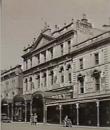Gaiety Theatre (Melbourne)
Gaiety Theatre (Melbourne)
i(A143563 works by)
(Organisation)
assertion
(a.k.a.
The Roxy)
Born:
Established:
1890
Melbourne,
Victoria,
;
Died:
Ceased:
1934
Melbourne,
Victoria,
AustLit
The material on this page is available to AustLit subscribers. If you are a subscriber or are from a subscribing organisation, please log in to gain full access. To explore options for subscribing to this unique teaching, research, and publishing resource for Australian culture and storytelling, please contact us or find out more.
BiographyHistory
Most Referenced Works
Notes
-
Entries connected with this record have been sourced from on-going historical research into Australian-written music theatre and film being conducted by Dr Clay Djubal.
Last amended 8 Feb 2014 11:42:50


